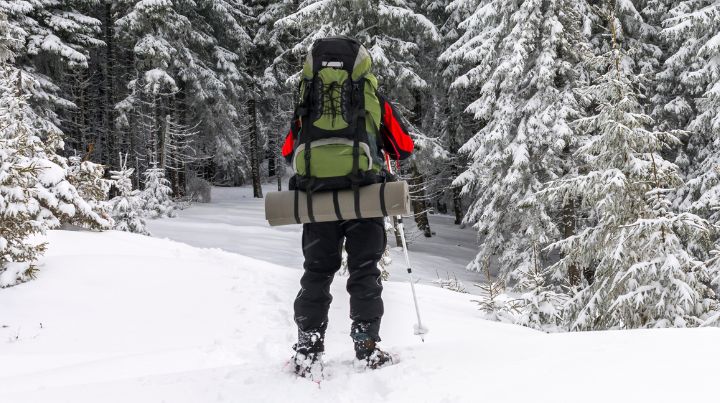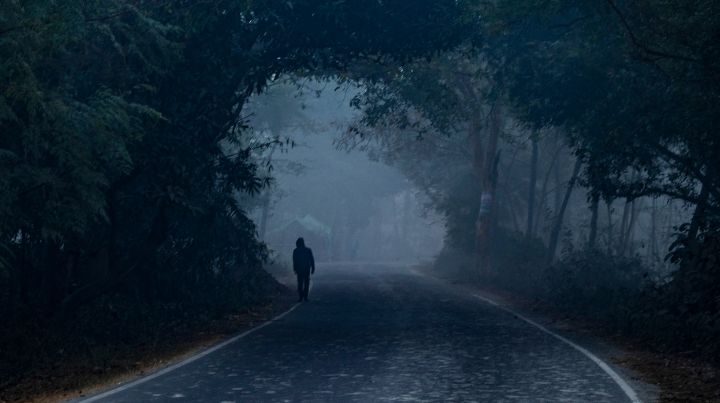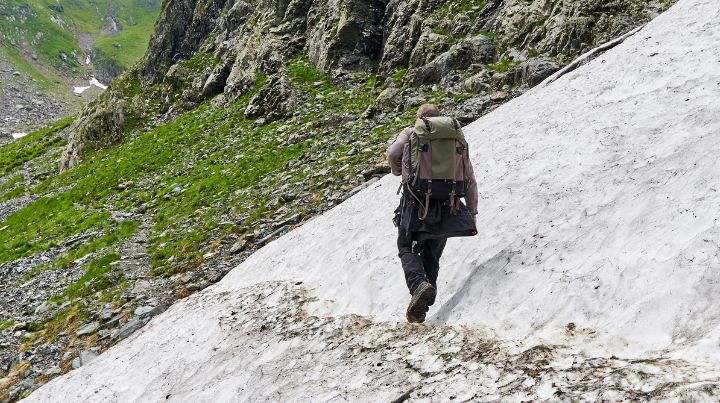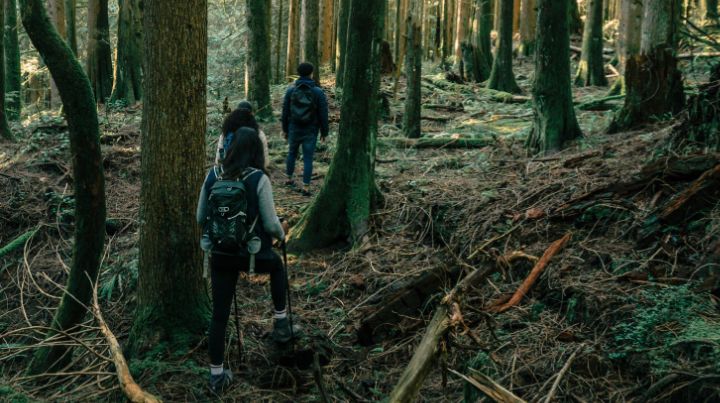Bugging Out on Foot in Winter

Greetings, Readers! Rest assured: this piece isn't a variation of Robert Frost's poem, “Stopping by Woods on a Snowy Evening.” Or is it? Prose or poetry is where you find it, and (as Shakespeare said) “the play's the thing.” When it comes to “bugging out,” you want neither comedy nor tragedy when the curtain rises on your performance…as it is a matter of life and death.
I prefer the term “E and E,” or “escape and evasion,” to “bugging out,” and we'll use it here. There are a host of different variables you'll have to consider, which are not always predetermined. Flexibility is the name of the game: to be able to adapt to changes in your surroundings…the environment. Let's jump into it!
First, let's throw some basics into the equation.
Rule 1: Move Only at Night, Except When Day Movement Is Necessary or Unavoidable

This may seem simplistic, but it's not. Understand first what we are as a species: a predator with forward-pointing eyes. The eyes “key” on motion first and then changes in color and shape second. To be sure, motion is still detectable at night, but the absence of light significantly reduces it, as well as removing color and shape from the equation.
Move at night, and always utilize your terrain for concealment. Crouch, when walking, to present less of a human-sized silhouette. Vehicles, buildings, hedges, alleyways (not closed ones!)…all help in an urban environment. In the woods, it's more conducive, as the terrain is referred to as “close,” with vegetation, and spots to lie down are more readily available.
Also, remember the circadian rhythm. It governs you, and it also governs your pursuers. They're tired at the end of the day…the serotonin-melatonin cycle is kicking in for them. They'll be less observant, more inclined to dismiss something, and not eager to chase after something that might harm them.
Rule 2: Parallel the Terrain and the Season

You must learn to blend with your terrain and live with the land and the time of the year. Essentially, that means not sticking out like the proverbial sore thumb. Obviously, if you're in an urban environment, you'll be noticed walking down Main Street with “Real-tree” camouflage clothing and vegetation tied all over you. Blend. Conceal. Hide. Your job is to exfil, to escape, to evade.
In urban environments, you'll have to weigh your options more carefully than in the woods. What is that environment? What sections of town do you have to cross? Which neighborhoods are on your path? You'd better know if you'll be out of place just by your appearance.
We're also discussing winter movement here, although these techniques can be used in temperate weather. Camouflage is one thing, but evading in a double-breasted Armani with patent-leather shoes when it's ten below is impractical, if not ridiculous. If you have to play the part of “Mr. Urbanite Businessman,” then at least carry a handbag or suit bag with a change of clothing that's appropriate for the weather.
You want good hiking boots (I prefer Uncle Sugar's issue footwear, myself), some long johns, a pair of cargo pants, a thick sweatshirt, and a jacket of some type. Stick with “earth tones,” in terms of color. In an urban environment, once again, you don't want to raise “red flags” to people more interested in their soy lattes and lunch meetings than martial law. When it's convenient, change…and then execute the next rule ASAP.
Rule 3: Get Out of the City/Town/Village/Urban Area
The “Amityville Horror” precept applies: “Get out!” You do not want to be in the middle of an urban area. This poses a problem because most people live in an urban area, on either the East or West Coast…around 70% of the population.
Think about it. That's about 220 million people. If they're not incinerated in the initial strikes of a nuclear war or reluctant to change their conditioned routine? They'll all be running screaming into the night…doing the same thing. This brings us to the next point.
Rule 4: Don't Begin Your E and E Empty-Handed
4 A – (On You/Your Person)
We're talking about bugging out on foot here. In this regard, you'll be limited by what you can tote. You'll need supplies, and you should always have a backpack/rucksack loaded up and ready to go. In this order: Bullets, Beans, and Band-Aids. A firearm and ammo are essential and need to be readily accessible. You should be able to tote at least a gallon of water and food for two or three days at a minimum. Your military rations/MREs are good here, as they resist the low temperatures, are shelf-stable, and you can gobble them down on the run.
4 B – (Prepositioned Supplies)
An ounce of prevention or a pound of cure? I've done this. You can, too. Cache. Stash. Squirrel away. When do you know your final destination/objective? It's then a simple matter to emplace food, water, clothing, weapons, batteries, etc., along the route. This is where you're going to have to be smart. This article is not about caching, but we're going to spit out a few basics that will help you get started:
- Emplace the cache “off the beaten path,” where it's not likely to be uncovered
- Remember the frost line for your state! You emplace it in spring, and then you're faced with solid, frozen ground when you recover in winter…a definite “no-go” you want to avoid.
- Once it's emplaced? You don't touch or visit it again until you're recovering it.
- Make sure you “proof” your stash against weather, animals/insects, and the potential for human discovery. For the latter: don't stash it in an area where construction is taking place.
Rule 5: Speed Is Essential, But “Smooth” Is Speed

When you're E and E'ing, don't let the adrenaline take over. Clear your mind, and move with a purpose, but do not draw undue attention unto yourself! I mentioned “crouching” earlier to keep hidden and out of sight…but there may come a time when you'll have to walk straight out of a room full of people…without panicking the crowd. Nonchalant. Cool. Smiling…always smiling, or at least “optimistic” in your outward appearance.
Be confident, and move steadily, not choppily. “Smooth” cuts down on the mistakes and keeps those neurosynaptic end vesicles in your brain firing…plasticity of the brain…not “brain-lock.”
Rule 6: Have Multiple Plans
I know what you're thinking. That “should be at the beginning of the article, right?”
Wrong. You make your plan and have your nice route outlined for E and E, and then suddenly, you find that a big cloud of radioactive fallout is drifting right toward your E and E corridor. All of your cache points are compromised. Take this with you as a “supplementary” rule that is separate from the list:
The Situation Dictates
The mission remains the same, but the situation dictates the conduct of the mission.
In brief, you don't just game the E and E: you game the potential scenarios you may face. This means you must estimate what will happen, where it will happen, and the probable egress route from your location when the substance hits the fan.
The military teaches you the acronym PACE: primary, alternate, contingency, and emergency. That's good for a simple operation with specific goals and variables. The complexity of what will happen after Doomsday is more varied, with overlap. Martial law: OK. What if it's on the heels of a nuclear war? And rioting?
You need to take time to plan for these events to happen…individually and also simultaneously. You also must be prepared to “lose” a bunch of stuff in the short term to adjust your actions. Adapting is the name of the game.
Rule 7: Escape the Trap…by Never Going Into It to Begin With
If you want to survive urban rioting, government round-ups, nuclear war, or all of the above…you have to have the foresight to see these things coming…and be out of those urban areas before they occur. This means keeping abreast of current events and situations that are happening where you live…and also in the area you intend to escape to.
Now, let's cover some generalities.
Whose Woods These Are?
No, you'd better know whose “territory” you are/may be encroaching upon when you make a run for it into the woodline. “Safe” in the woods? Whose woods? Who (and perhaps, what) are in them near your location? If you want an idea, think of the movie or the book “The Road,” for a guideline. You'll need to rest, build/erect a shelter, eat, and drink. Nothing can be done if you're not in a secure area. Know where you are going, and know everything about that area or areas.
Fires
There are times that they're essential, such as an emergency (read Jack London's “To Build a Fire”), but for the most part, they violate light and smoke discipline. That returns to the concept of MREs for food. If you're going to make a fire, you dig a fire pit in the ground that is concealed. Keep the fire small and shielded from view. Better to burn during the daylight. A fire sticks out for an enormous distance at night. That you do not need.
Gore-Tex
Yes, definitely. Jacket, pants, and covers for the sleeping bag. Here's a good tip for you: habituate other humans you live/work with to seeing you in it, and then you won't look “out of the ordinary.” It's worth its weight in gold when you must stay warm and can't build a fire.
Tools
Gee, that covers it, huh? Tools, to be more specific, meaning the ones you carry on your person. At a minimum, you should have a means of building a fire. For starters, a good knife, a Leatherman-type tool, a small flashlight, safety pins, some 550 cord, a good (genuine) Swiss army knife, and a compass. Personally, I carry a lot more than these things. You'll also have to “game” this: the trade-off is for things to be a bit “bulky.” So what?
Better to have and not need to use than to need to use and not have.
Additional
I prefer the woods, and I live in the mountains. It's not an imitation of Thoreau, and it's not for vacation. It's all nice to talk about, but the “doing” of it is a different matter. It takes practice to know how to perform land navigation, build a fire with nothing but sticks, and move cross-country through three feet of snow…without snowshoes.
E and E in the wintertime means you'll have to be versed in survival skills…obtaining water and food, emplacing and utilizing caches, avoiding being followed or watched, and living off the land. This article gives the basics and will point you in the right direction. You should now have more questions than when you started.
Once again, it's the “doing” part of it that holds the key. Use the information on this site and other resources to effectively learn your “how-to's” that will enable you to survive. They say that “knowledge is power,” but then again, if you either don't employ it or cannot…then it's more a state of being powerless. You have the time to game it now. Don't be gaming it later on when things are “long in the tooth.” Learn now…how to “stop by woods on a snowy evening,” and not merely survive…but thrive in it. Good luck in your endeavors, and we welcome questions or comments. JJ out!
Additional Resources:
Related Articles
FREE Guide
Read the Best Seller
Join Mind4Survival
Stay informed by joining the Mind4Survival! 100% Secure! 0% Spam!
Affiliate Disclosure...
Mind4Survival is a free, reader-supported information resource. If you make a purchase through our link, we may, at no cost to you, receive an affiliate commission.
Do You Want To Be Ready No Matter What?

Download our free 39-page guide with interactive, 7-Day Emergency Kit Checklist and take the first step toward real preparedness.
- Know exactly where to start.
- Save time and money.
- How-to build a complete Basic Emergency Kit.
- Level up your safety and security.
Join Mind4Survival
Stay informed by joining the Mind4Survival! 100% Secure! 0% Spam!






Bugging Out in Winter Snow no one will every ready, Snow in feet not inches. Even the best will not make it!
I live in Montana for that time to bug out the roads not be plowed there will feet show and ice ! No one will
You’ll need to rest, build/erect a shelter, eat, and drink.? you have snow you can not get food you have no gas, and no help!
if you are not there you may need to think on how to set up your home for “shit hits the fan.” in that time all thigs will come to a stop!
no one will be under standing thy will take all that you have, how can you stop them? you may have your family with you, how can you help them?
Good advice and foresight. I like the E and E instead of “bugging out”. I will now use that. Thank you. I’m in amish country surrounded be thousands of acres of forests and farms. But knowing your territory and terrian and if possible people is extremely important with E and E. Yes . Great information!
Snow is a major challenge, personally I have about 30 miles to travel (if on foot, this is why exercise and fitness are important). Water isn’t a problem, even the snow is manageable but -20 and 40 mph winds will be the killer. I combat this by carrying lots of calories, insulated clothing and a wind barrier layer. Due to the remote wide open country (mainly low sage) I will have to cross, and being frozen, caching isn’t really practical. I believe in the golden hours (first 24-48 hours of an event, at least in my rural area) before people really start behaving badly. My plan is to move fast, keep moving for warmth and cover the majority of the wide open at night (snow is shallow on ridge tops and wind exposed slopes). Have a plan, have at least one backup plan and do not procrastinate, just go and go quickly.
Has anyone ever converted snow mobile for non-snow travel? A half track type vehicle? When I was a kid, in the 70’s, we had snowmobiles. We had one that had to have been built in 50’s. But I’ve been in the South, from Florida to Oahu for the last 40 years, so I’ve been out of the loop.
I would venture a guess that fewer than 25% of the preppers that plan on bugging out could make a go of it in the winter! Summer would be bad enough, but at least you wouldn’t be burdened with snow shoes or skis; heavy clothes, and other gear needed to stay alive. In the snow it would be bad enough, but the deeper the snow and the colder the temps, the more difficult the task and the lower the chances of making it. A waypoint cache would be a help, but you still have to reach it, locate it, and possibly dig it out, all problematic! And even if YOU are in top physical shape, unless you’re a “lone wolf” type,(also known as a moron) you will probably have a wife and possibly kids with you! While I have no plans to bug out, short of an out-of-control fire bearing down on the place, if I had to do it in the winter I would definitely want a toboggan or sled to haul things on, possibly a snowmobile to pull it,(I know, we’re talking bug-out on foot) or even a dog to hook to it. You are going to need lots of stuff, especially if your bug-put location is not well stocked. A pack would be hard-pressed to contain everything a person might need to survive for any length of time in adverse conditions, by which I mean sleet, snow, and cold temps. And speaking of time, what would be a two or three-day hike in good weather might be a week or more in the snow, and that is a best-case scenario.
Winter in the outdoors is survivable, look at people in Alaska and Canada, and might even be considered enjoyable, but not when you are having to hide and possibly run for your life or fight! I spent many, many days building shelters and snow caves as a kid, staying in them for hours on end regardless of the weather, but it was for fun and when the fun ended we went home. And we didn’t do it at a time when the social fabric of society was coming unraveled and people were out looking for things to make their survival easier. And if a person hasn’t strapped on snow shoes and hiked around to get the feel of them and get in shape there is a real treat in store for them! All in all, I would not be of a mind to bug out in the winter, preferring to take my chances at home, but for those that might have to consider such a thing, preparedness should take on a whole new meaning! And remember about nigh time movement: This is the day and age where everyone has access to thermal, infrared, and night vision! In addition to the tracks you will be making in the snow, these devices allow a person to see you at great distances, and not everyone watching you will be a good person! So much to consider!